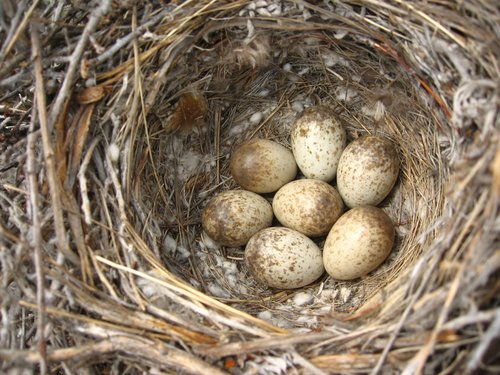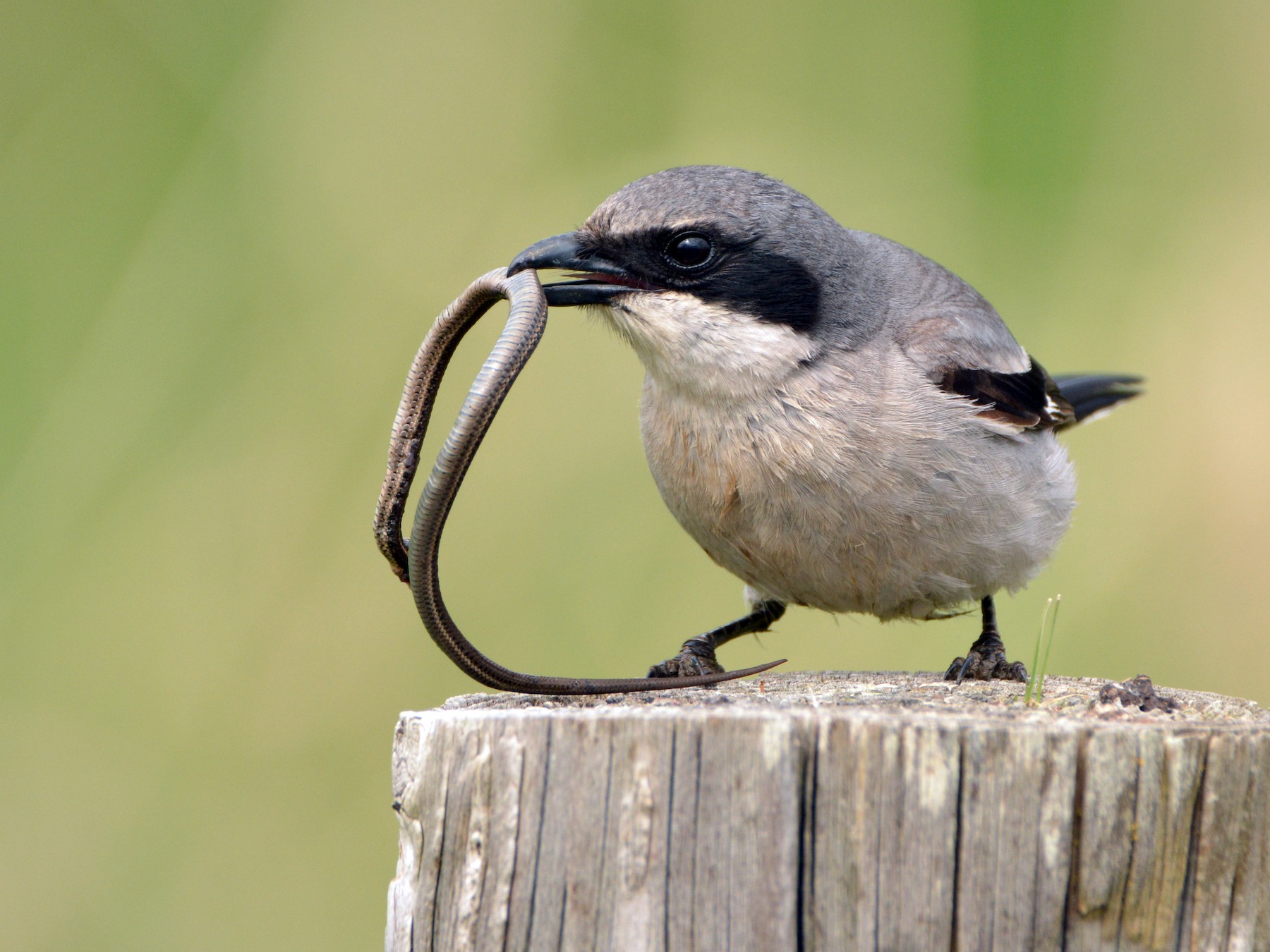
Eric Soehren of the Alabama State Lands Division prepares to band a loggerhead shrike that was captured on Dauphin Island.
Photo by Bob Farley
MONTGOMERY-Appearing like a miniature version of a mockingbird, the loggerhead shrike looks like any other songbird until you find evidence of the shrike’s lethal side.
“Some people call them butcher birds or French mockingbirds,” said Eric Soehren, biologist and manager of the Alabama State Lands’ Wehle Land Conservation Center in southeast Alabama. “They may look similar to a mockingbird, but they are very different in many ways. The shrike is a predatory songbird. They prey on a variety of small animals and can even kill birds heavier than they are. Many times, you’ll see their larders, which is where they have skewered their prey on a thorn or barbed wire. That’s where the butcher bird name comes from. It’s a songbird, but it’s an efficient killing machine.”
Although common in the mid-20th century, the loggerhead shrike has become a species of greatest conservation need because of declining numbers throughout its range. Soehren said the bird has a very wide distribution across the continent, but numbers in latitudes north of a Missouri-Kentucky-Virginia line have plummeted. Where it used to be a common species, the birds are now only found in small and isolated populations.
Fortunately in the South, sizable numbers of these birds still remain, despite not being as numerous in places like Alabama and Mississippi.
In response to that decline, the Loggerhead Shrike Working Group  (www.loggerheadshrike.org) was formed by researchers in Canada and the United States, made up of specialists who have studied the shrike as well as personnel from the non-game sections of state conservation agencies.
(www.loggerheadshrike.org) was formed by researchers in Canada and the United States, made up of specialists who have studied the shrike as well as personnel from the non-game sections of state conservation agencies.
“One of their primary tasks is shrike conservation, monitoring trends, habitat management on conservation lands on a state-by-state basis,” Soehren said. “Places like Indiana, West Virginia and Virginia have contributed to this for quite some time. However, states in the Southeast have not been a part of this until more recently.”
 Soehren said the group’s goal is to identify the problems affecting the shrike and why the species is declining. He said it’s likely a combination of impacts, like habitat alteration, pesticides and nest predation.
Soehren said the group’s goal is to identify the problems affecting the shrike and why the species is declining. He said it’s likely a combination of impacts, like habitat alteration, pesticides and nest predation.
“The group is trying to use modern science on a comprehensive scale to identify these needs,” he said. “One of the biologists in Virginia reached out to us in Alabama and asked if we would participate in the group, first because we have a lot of shrikes, relatively speaking, and because they didn’t have a lot of representation in the Southeast.”
To further involve Alabama, the technical working group asked that the annual meeting be held in the state. That meeting was held last spring at the Birmingham Zoo. The Alabama Department of Conservation and Natural Resources was represented by Soehren, along with Carrie Threadgill and Mercedes Bartkovich from Alabama Wildlife and Freshwater Fisheries’ Non-Game Wildlife Section.

Eric Soehren
“One of the fundamental things of monitoring wildlife is to mark individuals, whether by banding, ear-tagging or radio collars in animals like deer,” Soehren said. “The idea is to see what happens to that individual animal during a course of time – their movements, their habitat use, longevity and survivorship. This has been going on all over the state.
“One of the things we’re looking at is the movements of the species. They are short-distance migrants. Birds that breed in the northern limits of their distribution range migrate south in the winter. A lot of the birds that come into north Alabama in the fall and winter are northern birds.”

Range of the Loggerhead Shirke
Soehren said several state agencies have made a significant effort to band as many shrikes as possible. While the members of the working group are actively monitoring, the group also depends on the public to help with the effort.
“The idea is if you see a banded bird, report it,” he said.
A banding scheme with different color combinations was devised to provide re-sighting opportunities for researchers and casual observers. Birds banded in each state are assigned unique colored bands, making it easy to determine where the bird originated. A master list of color combinations for bands is compiled and managed by the group for identification.
“If a bird is sighted with color bands, there is a master list that can be used to say, ‘Oh, this bird was spotted in Alabama but banded in Virginia,’” said Soehren, who said the master list is reserved for the researchers.
Another aspect of the banding is being able to identify individual birds during the breeding cycle, like a paired male and female.
“A lot of the loss is likely happening at the nest,” Soehren said. “Pairs are nesting, raising young, but one of the critical aspects is that recruitment is falling below critical mass. It looks like a lot of the birds are not surviving through the first year. They may fledge, but they’re just not surviving.
 “To better understand what’s going on, the birds are banded and monitored through the entire nesting process. It’s kind of a laborious effort, but if you have a good eye for finding nests, it will help us monitor these nests through the duration from nest building to fledging, and watching what the fledglings do afterwards.”
“To better understand what’s going on, the birds are banded and monitored through the entire nesting process. It’s kind of a laborious effort, but if you have a good eye for finding nests, it will help us monitor these nests through the duration from nest building to fledging, and watching what the fledglings do afterwards.”
The working group is also collecting feathers and blood samples for genetics work to study the complexity of shrike populations across the continent.
“Understanding what population is where and how populations are mixing has conservation merit and bearing,” Soehren said. “If a population is found to be genetically unique, it deserves more immediate protection efforts than the populations that are more widespread and common.”
The working group is also developing models for locality and habitat use that will provide information on the areas more likely to harbor shrikes so state agencies can prioritize conservation efforts.
“We’re at the beginning stages of better understanding shrikes in Alabama,” Soehren said.  “We’re kind of limited by the number of people who can work with this species. The public can go out and identify these birds. What’s really been nice is eBird (ebird.org), which has been a wonderful tool. People provide sightings at specific locations. That provides a snapshot of distribution, not only in Alabama, but around the continent.”
“We’re kind of limited by the number of people who can work with this species. The public can go out and identify these birds. What’s really been nice is eBird (ebird.org), which has been a wonderful tool. People provide sightings at specific locations. That provides a snapshot of distribution, not only in Alabama, but around the continent.”
Soehren already knows that shrike populations have significantly declined in north Alabama, compared to the numbers seen in the 1960s and 1970s.
“Something is going on in the Tennessee Valley region compared to the rest of the state,” Soehren said. “Places like the Black Belt region and along the Gulf Coast still have sizeable numbers of shrikes.”
Despite limited resources, members of Alabama’s shrike group go out and opportunistically capture shrikes under agency permits.
“We’ve taken the approach that we’re going to band birds where there are a lot of birds present,” Soehren said. “We’re going to band in areas where people can re-sight these birds and report them. We’ve talked to birders about adopting areas to monitor banded shrikes. A lot of times, they already know where paired birds nest. If the birds are banded, these birders can be our eyes and share that information with us because we do not have the staffing resources to monitor consistently. We have to rely on others to help us with that information.”
One of the hotspots for shrike activity is Dauphin Island, the barrier island south of Mobile. Dauphin Island has a dedicated birding community, and the island has numerous bird sanctuaries. Lakepoint State Park near Eufaula is also another location with a significant shrike population.
“Birds banded at Dauphin Island are a good example of the public helping with the monitoring,” Soehren said. “There are about four or five nesting pairs on the island, so there are quite a few shrikes down there.”
Soehren was on the island for an Alabama Ornithological Society meeting and took the opportunity to bring his trapping gear.
“I was able to capture and band two birds really quickly,” he said. “We banded them in October. Since that time, we’ve had two separate birders report them to the Bird-Banding Lab (www.reportband.gov), which is what you’re supposed to do when you see a banded bird.”
 Although Audubon’s Christmas Bird Count has recently been completed, Soehren said anyone can help give the agencies a picture of the local bird populations during the winter.
Although Audubon’s Christmas Bird Count has recently been completed, Soehren said anyone can help give the agencies a picture of the local bird populations during the winter.
“The Christmas Bird Count provides overall population information and reveals changes in distribution and abundance over time,” Soehren said. “Many species have declined significantly, some meriting listing on the Alabama State Wildlife Action Plan (SWAP). But there are also examples of increases. The North American waterfowl populations have increased over 50% since 1970 due to a lot of the management efforts throughout their range. Revenues derived from the sale of duck stamps and hunting licenses have been reinvested in land conservation. We have bigger bag limits and longer seasons as a result.
“What’s great about the Christmas Bird Count is it’s open to anybody and everybody interested in birds. It’s not just for experienced birders. Everybody can get involved. If you’re a retiree just watching feeders, it all goes into the big pot of information. It helps us at the Alabama Department of Conservation and Natural Resources in our effort with non-game species.”
Visit www.audubon.org/conservation/
Media Release/DAVID RAINER/Alabama Department of Conservation and Natural Resources


